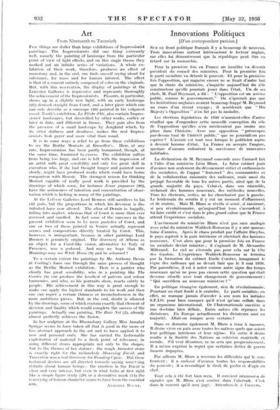Art
From Nineteenth to Twentieth FEW things are duller than large exhibitions of Impressionist paintings. The Impressionists did one thing extremely well, namely the painting of landscape from the particular point of view of light effects, and on this single theme they worked out an infinite series of variations. A whole ex- hibition of their work, therefore, produces an effect of monotony and, in the end, one finds oneself crying aloud for substance, for mass and for human interest. The effect is that of a concert entirely composed of solos on the virginals. But, with this reservation, the display of paintings at the Leicester Galleries is impressive and represents thoroughly the achievement of the Impressionists. Pissarro, in particular, shows up in a slightly new light, with an early landscape (21) derived straight from Corot, and a later piece which one can only describe as a sunscape (20) painted in his vulgarest mood. Tooth's exhibition, La Fleche d'Or, also contain ImpreS- sionist landscapes, but diversified by other works, earlier or later in date, and different in theme. They gain also from the presence of a small landscape by Jongkind which, by its titter dullness and deadness, makes the real Impres- sionists look gayer and more vital than usual.
It is in some ways a relief to go from these exhibitions to see the Berthe Morisots at Knoedler's. Here, at any rate, Impressionism has been partly humanised, though, at the same time, feminised to excess. The exhibition suffers from being too large, and one .is left with the impression of an artist with great sensibility and only too great skill in execution who, if she had thought longer and painted more slowly, might have produced works which could have borne comparison with Renoir. The strongest reason for thinking Morisot capable of really good work is provided by the drawings of which some, for instance Jenne paysanne (80), have the seriousness of intention and concentration of obser- vation which is lacking in many of the paintings.
At the Lefevre Galleries Lord Berners still sacrifices to his old gods, but the proportions in which his devotion is dis- tributed have now altered. The altar of Derain is, happily, falling into neglect, whereas that of Corot is more than ever incensed and candled. In fact some of the canvases in the present exhibition seem to Le mere posliches of Corot, and one or two of those painted in Venice actually represent scenes and compositions directly treated by Corot. This, however, is unimportant, because in other paintings Lord Demers is genuinely original. The discovery of Athens as an object for a Corot-like vision, alternative to Italy or Provence, was a godsend. And may we hope that Mr. Munnings may see While Horse (9) and be ashamed ?
To a certain extent the paintings by Mr. Anthony Devas at Cooling's force one through the same process of thought as the Berthe Morisot exhibition. Here is a painter who clearly has great sensibility, who in a painting like The Garden (9) can produce the loveliest of pattern and colour harmonies, and who, as his portraits show, reacts subtly to people. His achievement in this way is great enough to make one apply the highest standards to his work and then one can regret a certain thinness or inconclusiveness in the more ambitious pieces. But, in the end, doubt is silenced by the drawings, some of which contain exactly that element of decision and finality which would complete the success of the paintings. Actually one painting, The Hair Nei (2), already almost perfectly achieves the fusion.
In her sculpture at the Bloomsbury Gallery Miss Annabel Sprigge seems to have taken all that is good in the more or less abstract approach to the art and to have applied it to new and personal ends. She has carried the fashionable exploitation of material to a fresh point. of relevance, in using different stores appropriate not only to the shapes, but to the themes of her statues : the rough Ancaster stone is exactly right for the melancholy. Mourning David, and Travertine was a real discovery for Brooding Cynic. . But these technical devices arc all directed towards saying something definite about human beings : the emotion in the David is clear and very intense, but even in what looks at first. sight like a simple figure study (20) or a decorative mask (14) the conveying of human character seems to have been the essential


















































 Previous page
Previous page